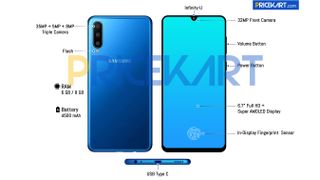
Samsung Galaxy A60 specs and features have leaked online – and, if they’re accurate, they give us our first good look at the device, and how it differs from Samsung’s latest flagships.
A spec sheet leaked via SlashLeaks gives a quick run-down of the Galaxy A60’s features – and if these specs are true, the A60 will be strong competition for Samsung’s flagship Galaxy S10 phones, with the phone getting a selection of advanced features.
Especially noteworthy is the mention of a tri-lens rear camera array, comprising a 32MP main sensor joined by a 8MP wide lens and 5MP tertiary snapper.
Given that none of the Galaxy S10 series has a 32MP rear camera, instead using 12MP main sensors with 16MP telephoto and 16MP ultra-wide lenses, if the leak is correct the Galaxy A60 may have a snapper to rival the S10’s – although the lens specializations of the S10 range shouldn’t be underestimated.
The A60 will also have a 32MP selfie camera, the leak suggests, which would surely hold a candle to the Galaxy S10’s 10MP front snapper (although the S10 Plus has a dual-lens front camera array, which lends itself to artistic portraits). If the leak is to be believed Samsung is going all out to make the A60 a photographic powerhouse.
According to the leak the A60 will also come with an in-screen fingerprint sensor, a feature missing from the Galaxy S10e, the 'budget' S10 device.
There are also a few other things the A60 has over the S10 range, if the leak is to be believed – it has a 4,500mAh battery, while the 6.7-inch AMOLED display would only be matched in size by the Galaxy S10 Plus 5G, the super-sized S10 device.
Another leak, of renders of the A60 via PriceKart, show how these features could fit on the Galaxy A60. The images show the vertical rear camera layout and bezel housing a front-facing camera, although it’s worth noting that it puts this selfie camera at 35MP instead of the other leak’s 32MP – so at least one of these leaks must be inaccurate.
The first leak also gives a rough launch date of April 2019, and says the phone will release with 128GB memory and either 6GB or 8GB of RAM, and we’re hoping to see it in the next few months.

The Galaxy A range has traditionally been a more affordable alternative to the pricier Galaxy S flagship range, so we don’t expect prices for the Galaxy A phones to be near those of the Galaxy S handsets. The Galaxy A50 will release between €300 (roughly $340, £260, AU$475) and €400 (around $450, £350, AU$630), and the A60 looks like a slight increase in terms of specs, so expect its price to be just a touch higher.
With such great features for a budget device, the leaked specs do seem a little too good to be true, so we’re taking them with a pinch of salt for now. Alternatively, perhaps the A60 will be a little closer in line with the S10s in terms of price – we’ll have to wait for some official line to be sure either way.
The A60 would join various other Galaxy A handsets – we’ve already gotten hands-on with the A30 and A50, and heard a little about the A10, but there’s also talk of an A40 and A90 being in the works too. While we’re a little confused about the numerical order, we’re intrigued to see how these devices will compare to the Galaxy S10 series.
Comments
Post a Comment